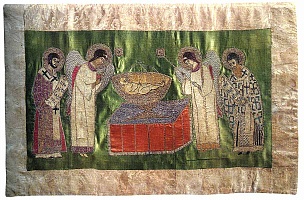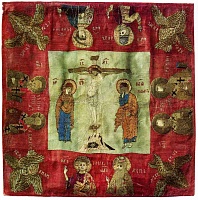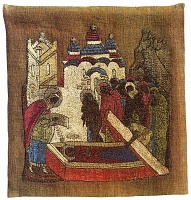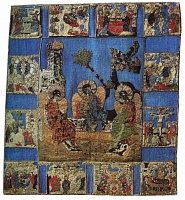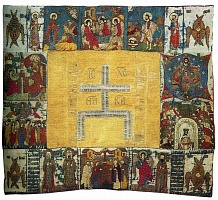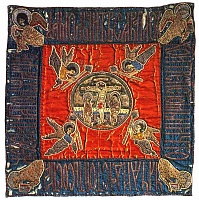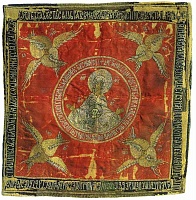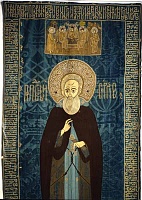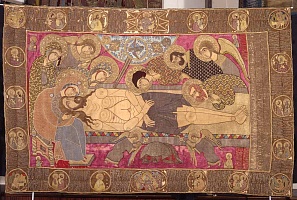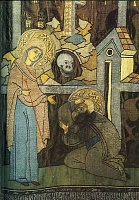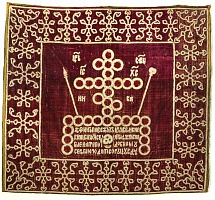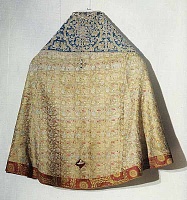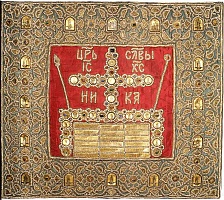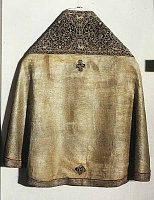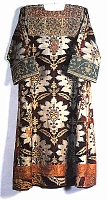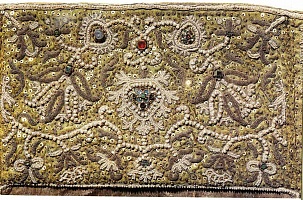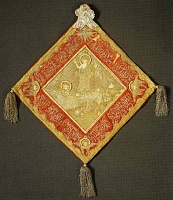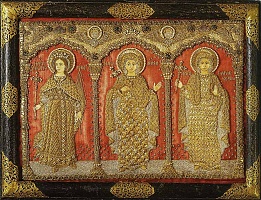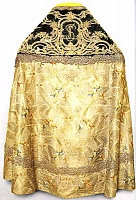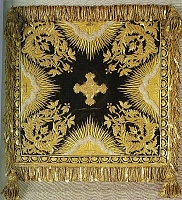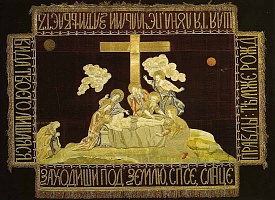Icon and Ornamental Embroidery of the 14th – 19th Centuries
An important place in the Museum collection is occupied by the I5th - I7th century embroidery. Compared with the similar col¬lections in our country it is not large (200 odd items). But its historic and artistic value is actually unsurpassed. Based on the col¬lection of the Trinity-St. Sergius Monastery, it comprises reliab¬ly recorded and signed works, connected with the leading Moscow work¬shops reflecting the development of this art in the course of three centuries. The collection presents various figurative and ornamental compositions embroidered in multi-colored silks, gold and silver thread and pearls. It acquaints with an original sphere of Russian medieval art, which had much in common with icon-painting and folk art.
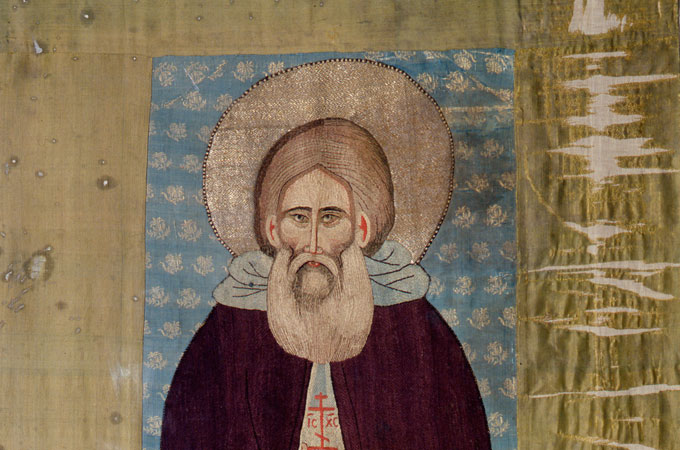
The embroidered items were greatly appreciated and carefully preserved. They were frequent donations to the major monasteries. Works of art: icon-cloths, palls and shrouds, icons, ancient books and church vessels of precious metals alongside with land and money - were donated to the Trinity-St. Sergius Monastery. The embroideries were produced in special workshops. Well-trained needlewomen worked there. The workshop was usually supervised by the lady of the house – boyarynia, princess, tsarina, who was often a skilful embroiderer herself. Since the I5th century the leading place belonged to the Grand .Prince workshops, which since the mid-l6th century were called "tsarina's chambers''. The collection of icon-embroidery of the first half of the 15th - early 16th century is most comprehensive . It was the time when icon-painting flourished in Russia as the result of general revival of Russian lands. Icon-painting led to the reinforcement of pictorial na¬ture in embroidery as well.
Icon Embroidery
The monuments of the first half of the I5th and early I6th century are most valuable. It was the time when icon-painting flourished in Russia. It led to the reinforcement of pictorial nature in embroidery as well. But other materials and techniques made the embroidered items very special. Stitched in multi-colored silks and gold and silver threads on textiles of selected color and texture, embroideries were always impressively decorative. The earliest specimen in the collection dates back to the early I5th century. It is the shroud depicting "The En¬tombment". The main work of the 15th century Moscow embroidery is the pall "St. Sergius of Radonezh" which was obvious¬ly created for canonization of the Trinity Father Superior in 1422. Quite a group of small icon-cloths, depicting different Christian feasts, is referred to the first half of the 15th century.
The 15th century embroideries can be described as specimens of picturesque style. Their expressiveness was achieved with the help of local colors of silk threads covering certain surfaces like paints. Sometimes they used different shades of the same color to model figures. Besides, needlewomen used special techniques: the so-called “satin” stitch and the “stem” stitch breaking the thread of the previous stitch with a needle, that made embroidery thick and durable.
Three small works: “The Crucifixion and Selected Saints”, “The Trinity and Church Feasts” and “ The Burial of St. Anna” - are remarkable samples of the mid-15th century. The purificator depicting “The Crucifixion and Selected Saints” was probably embroidered in the Grand Prince workshop. The designer of “ The Trinity and Church Feasts” was evidently impressed by the images of Andrei Rublev. All items demonstrate the needlewomen’s refine artistic taste. Embroidery in multi-colored silks is perfectly combined with the fine texture of silk taffeta. Gold threads made it even more exquisite.
The late 15th and the first quarter of the 16th century are represented by a number of outstanding specimens. Among them there are widely known and precisely dated works of the Grand Prince workshops, as well as, anonymous masterpieces of the Moscow boyars’ and service men’s workshops. These samples show the evolution of embroidery that carefully preserved the best traditions of the previous period. We can trace more gold and silver threads, more pearls and precious stones in them. They demonstrate accomplished technique of stitching. Some embroideries are perceived not only like paintings, but also like decorative and precious items. Gold, silver and precious stones conformed with the artistic conceptions.
The surviving Moscow monuments of the 15th century demonstrate great skill in gold and silver thread and multi-colored silk embroidery. However, till the first quarter of the 16th century colored silk threads were preferred. One of the most beautiful samples of that time is the purificator representing “The Miracle of Archangel Michael in Konya”. It still strikes with bright color scheme. The embroideries of the late 15th – early 16th centuries are noticeably influenced by Dionysius art.
Two small icon-clothes – “The Virgin of the Sign” and “St. Nicholas” are distinguished by the elegant elongated proportions, noble images, refined color range. “The Virgin of the Sign” is embroidered exclusively in gold and silver threads. The features of Dionysius art are most evident in embroideries made in the royal workshop of Vasily III and his wife Solomonia Saburova. Donated in 1525 their icon-cloth “The Appearance of the Virgin to St. Sergius of Radonezh, Church Feasts and Saints” is marked by elongated slender figures, fine drawing, refined colors and decorativeness. The Grand Prince artists frequently drew compositions for embroideries in the boyar workshops. Thanks to the embroidered inscriptions on the pall “The Crucifixion”, donated in 1514 by Boyarynia Anastasia Ovinova, we know the names of the artists: Andrei Myvedon and Anika Grigoriyev Kuveka.
In the middle and in the second half of the 16th century, the best embroideries were produced in the tsarina workshops of Anastasia Romanovna, Maria Nagaya, Irina Godunova. The pall donated in 1557 by Anastasia Romanovna, who was a skilful needlewoman herself, is marked by a rare composition and refined color scheme. In the 1580s, the monumental palls with the images of St. Sergius and St. Nikon of Radonezh were embroidered in the tsar workshops.
One of the most significant workshops in the 1550s and 1560s belonged to Princess Euphrosyne Staritskaya. The large monumental aers (shrouds) with many-figured compositions and elaborate ligature inscriptions were made there. Beautiful in design and composition, very harmonious in color scheme, they are perceived as monuments of both figurative and decorative art.
Embroidery in silk threads, stitched thickly in different directions producing light and shadow effects in faces, became more complicated. The superb technique of embroidery in silver threads, stitched down at intervals, permitted to create diverse ornaments. The embroidered inscriptions in complicated ligature are characteristic of that time. In 1561, the workshop of Euphrosyne Staritskaya produced the large aer (shroud) “The Entombment”. The embroidered donation inscription records that it was presented to the Trinity-St. Sergius Monastery by Prince Vladimir Andreyevich and his mother Euphrosyne “in memory of the last appanage family”.
In the late 16th – early 17th century, the embroidery workshops of Boris Feodorovich Godunov occupied a notable place. Preserving superb technique of embroidery in silk, gold and silver threads and high icon-painting style, the works of the Godunovs’ workshop became even more decorative. They turned into precious items due to numerous pearls, precious stones, gold and silver plaques of different shapes and sizes decorated with engraving and niello. The precious decorations were not end in themselves. The great skill always made them fall into line with complicated artistic tasks.
There were two periods in Godunovs’ embroidery. The boundary between them was 1598, when Boris was declared Tsar. The pall, depicting “The Appearance of the Virgin to St. Sergius” with the Golgotha cross in the background, is referred to 1587. Between 1598 and 1604, Boris Godunov presented the Trinity Monastery with a set of embroideries for church vessels including the purificator with the scene of “The Trinity” that followed Andrei Rublev icon in composition.
The 17th century embroidery in the Museum collection is represented by a number of interesting specimens from the tsarina workshops and the workshops of “the notable people” Stroganovs. The Stroganovs’ main donations are referred to the 1660s – 1670s. They are connected with Dmitry Andreyevich, his wife Anna Ivanovna and their son Grigory. In 1671, Anna Ivanovna Stroganova donated the pall with the image of St. Sergius to the Trinity-St. Sergius Monastery.
Ornamental Embroidery
Alongside with icon embroideries the exhibition presents interesting samples of ornamental embroidery. They are mainly church vestments, icon-cloths and purificators decorated with ornamental compositions of gold and silver threads, pearls and precious stones. The earliest specimen in the Museum collection is the liturgical cuff depicting “The Annunciation” of the late 15th century. It originated in the Grand Princess workshop of Sophia Paleologus. The ornament played a modest role at that time. It framed the embroidered composition. Its main motif was a stylized bindweed.
The 16th century works are most interesting. Among them there are outstanding samples made in the royal and famous princely and boyar workshops of Moscow. The phelonion, connected with the name of prince Pyotr Shchenyatev, is very attractive. Its shoulder-piece consists of several embroidered fragments of female attire, so it gives an idea of lay embroidery in the first place. The embroidered ornament – the tree “protected“ by animals and birds – is referred to the most ancient motifs. The ornament treatment and the pattern character are greatly influenced by folk art and folk tastes. There is hardly another work, reflecting in detail the traditional zoomorphic world – deer, horses, geese – of Russian folk embroidery.
In the mid-16th century, there appeared embroideries with floral and geometric patterns. Practically all of them date back to the middle and second half of the 16th century. They are mainly icon-cloths. The icon-cloth, donated by Anastasia Romanovna in 1550, is most important. “The Pearl Icon-Cloth” of 1599 demonstrates principal features of ornamental embroidery of the late 16th century: luxurious materials, combination with jewelry art, complicated and colorful compositions. Its decorativeness is ensured by numerous pearls and gold plaques, as well as, by multi-colored precious stones. On the one hand, Godunovs’ embroideries completed the development of ornamental embroidery in the 16th century, on the other hand, they opened a new period of fine colorful patterns of the 17th century.
The 17th century ornamental embroidery is richly represented in the Museum collection. Numerous pearls drawing the pattern, so to say, and plaques of different shapes, imitating flowers and leaves, remained principal decorative materials. In the 17th century the ornaments on the shoulder-pieces and cuffs of liturgical vestments were just decorative, occasionally including elements of feudal symbols: snow-leopards, two-headed eagles and fancy birds. The characteristic sample is the phelonion with the shoulder-piece of embroidered details from a female attire, presented to the Trinity-St. Sergius Monastery in 1635 by Maxim, an archpriest of the Annunciation Cathedral and a confessor of tsar Mikhail Romanov. The exquisite embroidered pattern is emphasized by glittering pearls and mat bullion.
The sticharion of Turkish brocaded velvet with the shoulder-piece embroidered in pearls and gold and silver threads dates back to the same period. Among the samples of the last quarter of the 17th century there are few precisely dated works and all of them are of different character. The epitrachelion of red velvet, embroidered in a pearl thread combined with gold plaques, small garnets and turquoises, is typical. At that time they used the ornamental patterns of the 16th century. One of the most characteristic compositions was used in the vexillum, donated by boyarynia S.S. Morozova in 1667
The ornamental embroideries of the last three decades of the 17th century are rather interesting. They are marked by rich, colorful and complicated floral patterns. The colorful compositions are emphasized by numerous studs with multi-colored stones, enamel, golden spangles. All decorative elements corresponded to optimistic spirit of the 17th century Russian art.
Boyar A.S. Shein’s donations give an idea of a boyar workshop, where the needlewomen could use a great deal of techniques in pearl, gold and silver thread embroidery. At the late 17th century new trends in ornamental embroidery could be traced. They are brightly manifested in the phelonion shoulder-piece embroidered between 1674 – 1697. The effect of its decorative composition was achieved by the magnificent design and multi-colored stones in gold studs, as well as, by the new function of pearls. Through the whole medieval period great attention was paid to floral ornaments, once connected with Slavonic pagan symbols of plant fertility.
Icon and Ornamental Embroidery of the 18th – 19th Centuries
The famous epigonation depicting “The Resurrection of Christ” was donated to the Monastery sacristy among other numerous items in the 18th century. It is a work of superb technique. Archimandrite Varlaam (Vysotsky) used it in his gala vestment in St. Petersburg. Finest satin stitching was additionally colored with a brush. That was a characteristic feature only of the first quarter of the 18th century. Between 1737 and 1756 the exceptionally rare and beautiful small icon “Great Martyrs Catherine, Anna and Paraskeva”, embroidered in gold and silver over scarlet silk, supplemented the Monastery collection.
The Museum preserves a phelonion with the monogram “TSL” rendering the new title of the Trinity-St. Sergius Monastery in Latin. It is embroidered in pearls in the center of the pearl ornaments on the shoulder-piece. The Monastery was entitled Lavra by the order of Empress Elizaveta Petrovna. The phelonion reflects great achievements in Russian pearl embroidery.
During the rein of Catherine II the royal house was closely connected with the Monastery. Empress visited the Monastery more than once. New vestments were made for the royal court sacristy of the Trinity Archimandrite. The surviving articles are phelonion, epitrachelion, epigonation and sticharion. The vestments are made of silver brocade and embroidered in silks, chenille and golden threads so skillfully that they look like textiles woven by the best European manufactories.
The purificators for church vessels are splendid specimens of the 18th century embroidery. They are of dark green velvet, embroidered in gold and silver and decorated with “gold bullion, fringe and spangles, in the corners there are… four gold bullion tassels”. This set of purificators was embroidered in the royal zhlmeister office. The workshop of the Trinity-St. Sergius Lavra produced the shroud representing “The Entombment”. The Sakkos of Filaret (Drozdov), Metropolitan of Moscow and Kolomna, is a remarkable sample of the 19th century embroidery











